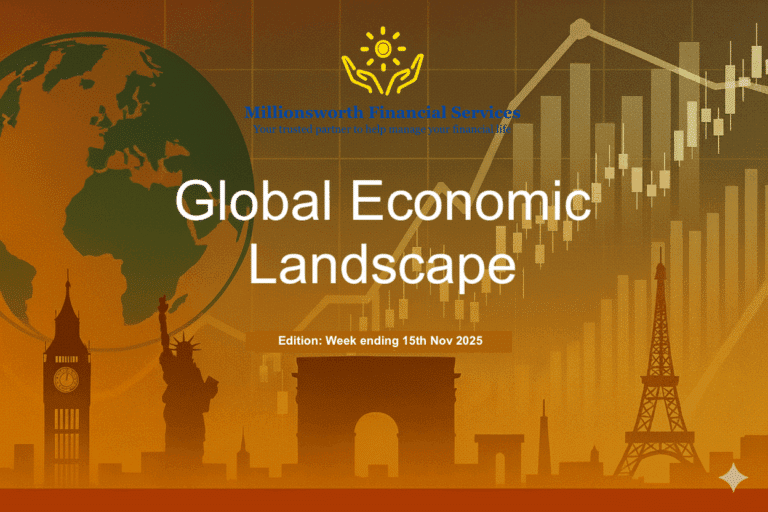As global economies wrestle with inflation persistence, uneven growth, and shifting sectoral momentum, this week’s macro data offers a layered view of where opportunity meets caution. From the Federal Reserve’s policy tightrope to China’s auto-led resilience, Japan’s mixed signals, and the UK’s steady pace—investors are navigating a world that’s no longer moving in sync, but still full of tactical openings.
🇮🇳 India: Reform Momentum Meets Inflation Uptick
India’s macro landscape this week was marked by a blend of reform-heavy policy action and a modest uptick in inflation. Consumer price inflation accelerated to 2.07% in August, up from a revised 1.61% in July, driven by food and fuel price adjustments. Despite external headwinds, Fitch upgraded India’s FY26 GDP forecast to 6.9%, citing resilient domestic demand and fiscal support.
The government continued its reform push with the launch of the ‘Gyan Bharatam’ portal to preserve ancient manuscripts, and new licensing policies for opium poppy cultivation. Investment momentum remained strong, with Maharashtra securing deals worth ₹1.08 lakh crore across IT, food processing, and logistics. India also signed seven MoUs with Mauritius and a $126 million loan agreement with ADB to promote sustainable tourism in Uttarakhand.
On the regulatory front, SEBI approved a single-window clearance system for foreign portfolio investors and eased norms around minimum public offer timelines. It also proposed ending weekly F&O contracts and introduced co-investment schemes for accredited investors. Meanwhile, NPCI raised UPI transaction limits to ₹5 lakh per payment and ₹10 lakh per day in select categories, signaling deeper digital integration.
For investors, India presents a compelling mix of macro stability and reform-led momentum. Equities in infrastructure, tourism, green energy, and financial services may benefit from policy tailwinds. Bond investors should monitor inflation trends and RBI’s stance, with short-duration instruments offering a prudent entry point.
🇺🇸 United States: Inflation Sticky, Labour Market Softens
The U.S. economy continues to send mixed signals. Headline inflation accelerated to 2.9% in August, while core inflation remained unchanged at 3.1%, underscoring the Fed’s challenge in taming price pressures without derailing growth. Producer prices eased to 2.6%, offering some relief to corporate margins, but the labour market showed fresh signs of strain. Initial jobless claims jumped by 27,000 to 263,000—the highest since 2021—while a downward revision of 911,000 jobs to earlier payroll data revealed deeper cracks in employment momentum. Small business sentiment nudged up to 100.8, but hiring intentions remain cautious, reflecting broader uncertainty.
For investors, this backdrop calls for defensive positioning. Equities in small-cap and non-cyclical sectors may outperform as rate-sensitive names face valuation pressure. On the bond side, intermediate-duration Treasuries and inflation-protected securities (TIPS) offer a hedge against both inflation and policy volatility, especially as the Fed leans dovish in response to labour market softness.
🇯🇵 Japan: Domestic Demand Strong, Industrial Output Slips
Japan’s economy showed strength in domestic fundamentals but weakness in industrial momentum. Q2 GDP grew 2.2% year-on-year, a sharp rebound from Q1’s sluggish 0.3%, driven by resilient consumer spending and business investment. Bank lending rose 3.6%, and producer prices climbed 2.7%, pointing to cost-push inflation. Sentiment improved, with the Economy Watchers Survey rising to 46.7—its highest since January. Yet, industrial production fell 0.4% in July, reversing June’s 4.4% gain and highlighting external demand challenges and supply chain friction.
Investors may find opportunity in domestic cyclicals and financials, which stand to benefit from rising credit appetite and internal demand. Export-oriented sectors, however, may face headwinds from yen volatility and global trade uncertainty. Bond investors should consider short-duration and inflation-linked JGBs, as rising yields reflect the Bank of Japan’s gradual pivot toward normalization.
🇨🇳 China: Auto-Led Momentum, Inflation Still Muted
China’s August data revealed a two-speed economy. Vehicle sales surged 16.4% to 2.857 million units, up from 14.7% growth in July, driven by strong EV demand and dealer incentives. This auto-led momentum contrasts with muted inflation: consumer prices edged up to 0.4%, and producer price deflation eased to –2.9%, suggesting tentative stabilization in industrial pricing.
For equity investors, the sweet spot lies in policy-supported sectors—electric vehicles, infrastructure, renewables, and consumer tech. These areas are likely to benefit from Beijing’s targeted stimulus and regulatory tailwinds. On the bond side, long-duration instruments remain vulnerable to rising core inflation and capital rotation toward equities. Selectivity and flexibility are key.
🇪🇺 Eurozone: ECB Holds Rates, Growth Remains Fragile
The European Central Bank held its benchmark rates steady—Deposit Facility at 2.00%, Main Refinancing Rate at 2.15%, and Marginal Lending Rate at 2.40%—signaling a cautious stance amid stable inflation and weak growth. With Q2 GDP barely growing at 0.1% and trade tensions (including U.S. tariffs on EU exports) clouding the outlook, the ECB reiterated its data-dependent approach without committing to further easing.
For equity investors, policy stability supports financials, infrastructure, and consumer sectors. However, export-heavy industries may struggle under external pressure. Bond investors should note that bund yields have begun to rise, making quality euro-denominated debt more attractive than longer-duration plays.
🇬🇧 United Kingdom: Steady Growth, Sector Divergence
The UK economy maintained its growth pace, expanding 1.4% year-on-year in July—matching June’s performance. Services and construction led the charge, while production contracted. Inflation remains elevated, and early signs of labour market softness are emerging. Despite this, the Bank of England is expected to hold rates steady, opting for stability over stimulus.
Equity investors may consider tilting toward domestic services and construction-linked stocks, which continue to show resilience. Bond investors should remain selective, with short-duration gilts offering a safer path amid policy ambiguity.
🧭 Cross-Market Strategy Snapshot
| 🌍 Region | 📈 Equities Focus | 💵 Bond Focus |
| 🇺🇸 US | Small caps, defensives | TIPS, intermediate Treasuries |
| 🇯🇵 Japan | Domestic cyclicals, financials | Short-duration, inflation-linked JGBs |
| 🇨🇳 China | EVs, infra, renewables, consumer tech | Avoid long-duration; rotate to quality |
| 🇪🇺 Eurozone | Financials, infra, consumer | Quality euro bonds; avoid duration risk |
| 🇬🇧 UK | Services, construction | Short-duration gilts |
| 🇮🇳 India | Infra, tourism, green energy, BFSI | Short-duration bonds; inflation-watch |
✍️ Millionsworth Takeaway
This week’s macro pulse reinforces the need for strategic agility. With central banks pivoting cautiously, inflation narratives diverging, and policy reforms accelerating in India, investors must stay nimble—balancing risk with opportunity through selective positioning, duration discipline, and sectoral insight. Whether you’re navigating volatility or chasing momentum, the key is to stay ahead of the curve—and that’s exactly where Millionsworth thrives.



